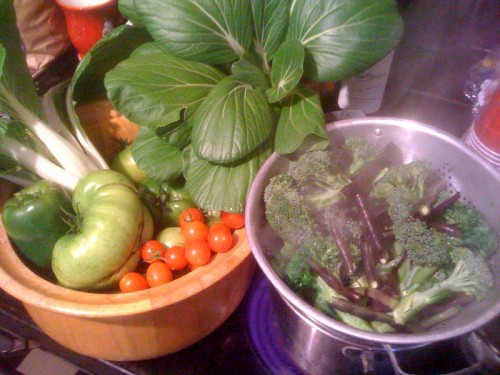
Garden Fairies Kiaralinda and Todd's fall harvest
If you have been hiding from the heat all summer, there is good news for Southern gardeners– September is a super time to starting planting again. Fall is a glorious time to fall in love with your garden again, when Mother Nature finally starts switching off the steam bath.
Southern gardeners inherently know, September is the time to plant crops like Summer Squash, Spinach and Tomatoes. If you are a transplanted northerner, initially it takes a bit of recalibrating your mindset.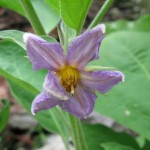
Mornings and late afternoons, especially after a rain shower when the humidity is lower, is a great time to get out in the yard. If you want to save money, start seeds now, just make sure keep up with watering the seedling. Choose a spot in the shade, as it is easier on you and the seedlings.
Most vegetables and easy care annuals can be grown in situ, which means sowing your seeds where they are to flower. You can either broadcast your seeds or set them in rows. If you want to make a large area filled with annual seeds you can broadcast the seed.
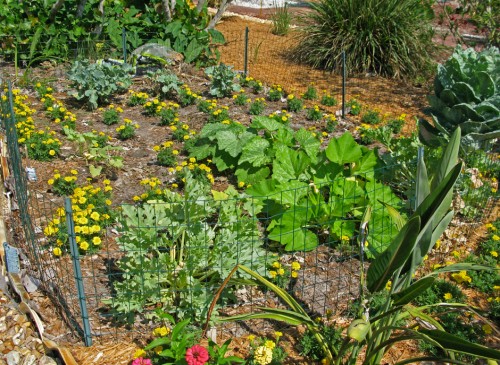
Garden Fairy Barbara's garden a combo of veggies and marigolds
Prepare the ground before sowing the seeds, making sure there are no large lumps of soil or stones, and then rake over the surface to give a fine “tilth”— a smooth surface with the soil broken down into small particles.
Much of the soil in Florida predominately is made of sand, which doesn’t hold nutrients or water well, making it a poor substrate for growing most vegetables. Nutrients wash out quickly when water hits the sand. Add organic matter to the soil which to help with nutrient retention and add nutrients.
I favor a combination of homemade compost, the most economical amendment, augmented with store bought mushroom compost. You can make compost out of a combination of vegetable scraps, dead leaves, grass clippings, tea bags, coffee grounds, cow sheep and horse manure. Some specialty nurseries sell chicken poop. Make sure your compost is well matured as immature compost can rob the soil of nutrients.
Consider planting a combo of ornamental vegetables and annuals. By the time Thanksgiving comes you will have a bounty to show off to your holiday guests, serving food fresh from the garden. If you have been checking in with your northern gardener friends, you know they are winding down their garden activity as the light changes, perhaps planting mums and planning to pick pumpkins.
Many of the Garden Fairies are off traveling in the summer and early fall, like Patti and Lowell and their dog Bailey who came upon a giant pumpkin patch. Patti reports the pumpkins in the patch were huge and there are still two months to go.
August is the time to start growing pumpkins in Central Florida, but you can stretch it a bit to September. If you find yourself nostalgic for changing leaves and fall harvests, satisfy your urge by creating a bit of fall in your Florida garden.
September plants:
Annuals
- Sunflowers
- Marigolds
- Nasturtiums
- Zinnas
- Ornamental Cabbage and Kale
Vegetables
- Beans (bush and pole)
- Broccoli
- Cabbage
- Corn
- Cucumbers
- Endive/ Escarole
- Eggplant
- Kale
- Lettuce
- Pumpkin
- Squash, Summer and Winter
- Turnips
- Mustard Greens
- Onions
- Peas- English and Southern
- Peppers
- Potatoes
- Radish
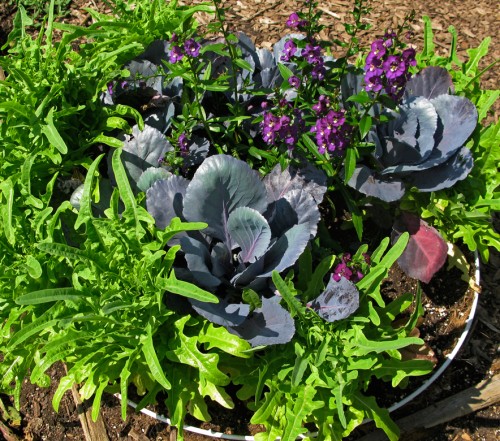

Garden Fairy, Dirt Girl Heather after a really dirty day



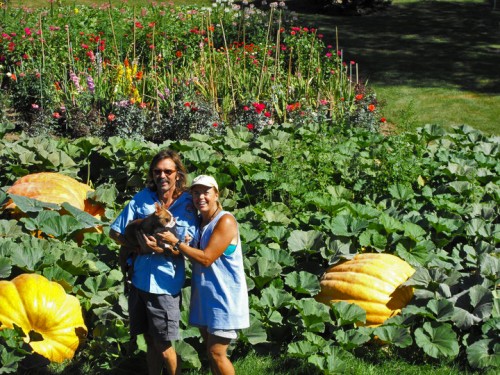
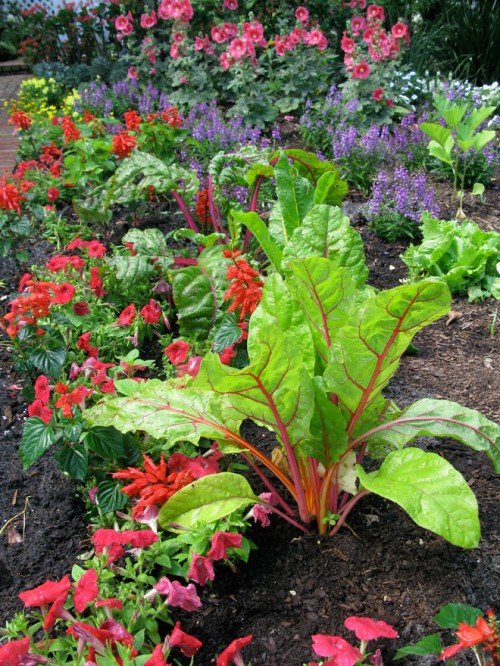

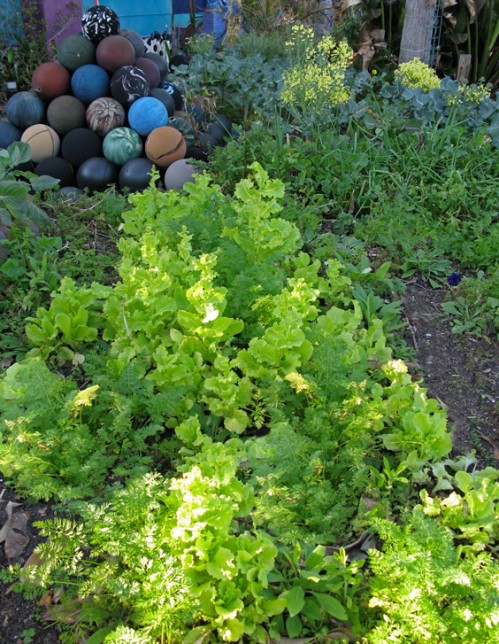


GREAT pictures. Loved seeing a little northern pumpkin action with Patti and Lowell. Thanks for the great information.
Makes me long for a longer growing season up here. . .I was cleaning gardens out to lay fallow over winter. Brrrrrrr. Always love to peruse Siobhan’s garden transformations. In my next life, I will live in a warmer climate and have her come transform my yard!!
Beautiful pics & great info to inspire us GFs!
A tip about planting flowers with veggies. Flowers don’t mind being crowded but veggies do, so be sure to leave lots of room for veggies to get the maximum amount of sun and air circulation. Sprawling vines such as squash and pumpkins take up lots of room. You might have space for only 3-4 squash vines and one pumpkin vine. Some vines like cucumbers and pole beans can be trellised. If you don’t have much space, look for container size veggies, especially tomatoes. Other veggies such as eggplant come in mini varieties. Try growing unusual varieties of your favorite veggies that you don’t see in the local grocery store – it doesn’t make much sense to put the time and effort into growing something you can get everyday at the market. Share seed with friends – one package goes a long way in several small gardens.
you hit the nail right on the head. I’m still recalibrating my seasonal mindset. It’s great to know that I can plant some things now. Are there any other flowers you can grow from seed now? Is it too late to try to propagate powder puff (last attempt failed)? As always, thanks for the inspiration!
Linda,
Yes, see the list on the post of flowers/ annuals you can plant now.
Propagating powder puff bushes is possible.
If your cutting did not take or rotted it could be the potting mix. A potting mix that is continuously waterlogged will increase your cuttings chance of rotting rather than forming roots. A mixture of 50% vermiculite/50% perlite holds sufficient air and water to support good root growth or any well-drained soilless potting mix is acceptable.
1. Make the bottom cut just below a node (a node is where the leaf and/or the bud joins the stem) from a stem about 5′ in length.
2. Remove flowers.
3. Nip off the last 3 sets of leaves, being careful not to damage the stem.
If you indadvertedly strip the stem it will not propagate.
4. Dip the lower inch of the cutting in rooting hormone.
5. Enclose the pot in a plastic bag, making sure the bag does not touch the leaves.
6. Place the pot in a warm, bright spot but out of direct sunlight. Every few days, check the rooting mix to make sure it is damp, and water as necessary. Discard any water that collects in the bottom of the bag.
7. After two or three weeks, check to see if roots have formed by working your hand under the cutting and gently lifting. If no roots have formed, or if they are very small, firm the cutting back into the mix, rebag, and check for roots again in one to two weeks.
8. Once roots have formed untie the plastic bag and then opening it a little more each day. When it is growing well without a plastic bag, pot in a good quality potting mix and move to its permanent location.